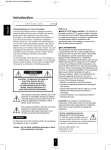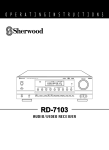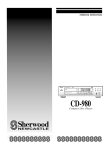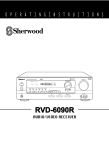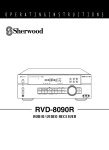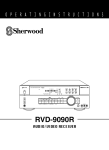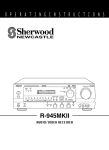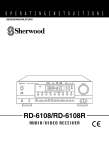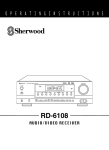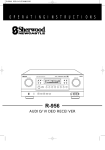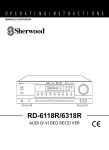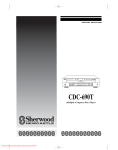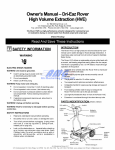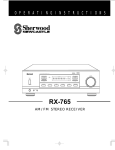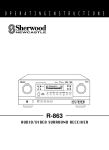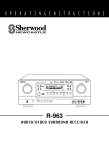Download Sherwood RD-7106 User's Manual
Transcript
O P E R A T I N G I N S T R U C T I O N S
T D A S
TOTALLY DISCRETE AMPLIFIER STAGE
MASTER VOLUME
ST TUNED
MAIN POWER
M
dB
kHz
MHz
DTS
ON/
TAPE
REMOTE
SENSOR
DIGITAL
PRESET
MEM
LOCK
ms
SLEEP
Pro Logic
OFF
INPUT SELECTOR
STANDBY
AUDIO
VIDEO
TAPE MON.
SURROUND MODE
6CH DIRECT
AUTO
DSP MODE
STEREO
DIGITAL
INPUTS
CHECK
ON/STANDBY
PHONES
SPEAKER
CHANNEL
SELECTOR
ADJUST
TONE MODE
SPEAKER
MODE
DYNAMIC
RANGE
VIDEO 4
CINEMA EQ MEMO/ENTER
TUNING/PRESET
T/P MODE
FM MODE
BAND
ON/OFF
S-VIDEO
VIDEO
RD-7106
AUDIO/VIDEO RECEIVER
L - AUDIO - R
Introduction
ENGLISH
UNPACKING AND INSTALLATION
Your new high fidelity receiver is designed to deliver
maximum enjoyment and years of trouble free service.
Please take a few moments to read this manual
thoroughly. It will explain the features and operation of
your unit and help ensure a trouble free installation.
Please unpack your unit carefully. We recommend that
you save the carton and packing material. They will be
helpful if you ever need to move your unit and may be
required if you ever need to return it for service. Your unit
is designed to be placed in a horizontal position and it is
important to allow at least two inches of space behind
your unit for adequate ventilation and cabling
convenience.
To avoid damage, never place the unit near radiators, in
front of heating vents, in direct sunlight, or in excessively
humid or dusty locations. Connect your complementary
components as illustrated in the following section.
CAUTION
RISK OF ELECTRIC SHOCK
DO NOT OPEN
CAUTION : TO REDUCE THE RISK OF
ELECTRIC SHOCK, DO NOT
REMOVE COVER (OR BACK).
NO USER-SERVICEABLE PARTS
INSIDE. REFER SERVICING TO
QUALIFIED SERVICE PERSONNEL.
This symbol is intended to alert the user to the
presence of uninsulated "dangerous voltage"
within the product's enclosure that may be of
sufficient magnitude to constitute a risk of
electric shock to persons.
This symbol is intended to alert the user to the
presence of important operating and
maintenance (servicing) instructions in the
literature accompanying the appliance.
WARNING
To reduce the risk of fire or electric shock, do not expose
this appliance to rain or moisture.
Caution : Do not block ventilation openings or stack
other equipment on the top.
FOR U.S.A.
Note to CATV System Installer: This reminder is
provided to call the CATV system installer's attention
to Article 820-40 of the NEC that provides guidelines
for proper grounding and, in particular, specifies that
the cable ground shall be connected to the
grounding system of the building, as close to the
point of cable entry as practical.
FCC INFORMATION
This equipment has been tested and found to
comply with the limits for a Class B digital device,
pursuant to Part 15 of the FCC Rules. These limits
are designed to provide reasonable protection
against harmful interference in a residential
installation. This equipment generates, uses and can
radiate radio frequency energy and, if not installed
and used in accordance with the instructions, may
cause harmful interference to radio communications.
However, there is no guarantee that interference will
not occur in a particular installation. If this equipment
does cause harmful interference to radio or
television reception, which can be determined by
turning the equipment off and on, the user is
encouraged to try to correct the interference by one
or more of the following measures:
Reorient or relocate the receiving antenna.
Increase the separation between the equipment
and receiver.
Connect the equipment into an outlet on a circuit
different from that to which the receiver is
connected.
Consult the dealer or an experienced radio/TV
technician for help.
CAUTION : Any changes or modifications in
construction of this device which are not expressly
approved by the party responsible for compliance
could void the user's authority to operate the
equipment.
Caution regarding placement
(Except for U.S.A. and Canada)
To maintain proper ventilation, be sure
to leave a space around the unit (from
the largest outer dimensions including projections)
equal to, or greater than, shown below.
Left and right panels: 5 cm
Rear panel: 10 cm
Top panel: 20 cm
2
FOR U.S.A. AND CANADA ................................. 120 V
FOR OTHER COUNTRIES ........................ 115 V/230 V
FOR YOUR SAFETY
FOR YOUR SAFETY
Units shipped to the U.S.A. and Canada are designed
for operation on 120 volts AC only.
Units shipped to countries other than the above
countries are equipped with an AC voltage selector
switch on the rear panel. Refer to the following
paragraph for the proper setting of this switch.
Observe all, safety precaution for use of a polarized
AC plug. However, some products may be supplied
with a non polarized plug.
AC VOLTAGE SELECTION
This unit operates on 115/230 V AC. The AC voltage
selector switch on the rear panel is set to the voltage
that prevails in the area to which the unit is shipped.
Before connecting the power cord to your AC outlet,
make sure that the setting position of this switch
matches your line voltage. If not, it must be set to
your voltage in accordance with the following
direction.
CAUTION : To prevent electric shock, match wide
blade of plug to wide slot, insert fully.
FOR EUROPE AND AUSTRALIA ......... 230 V/240 V
FOR YOUR SAFETY
Units shipped to Australia are designed for operation
on 240 V AC only.
To ensure safe operation, the three-pin plug supplied
must be inserted only into a standard three-pin
power point which is effectively earthed through the
normal household wiring. Extension cords used with
the equipment must be three-core and be correctly
wired to provide connection to earth.
Improper extension cords are a major cause of
fatalities. The fact that the equipment operates
satisfactorily does not imply that the power point is
earthed and that the installation is completely safe.
For your safety, if in any doubt about the effective
earthing of the power point, consult a qualified
electrician.
AC voltage selector switch
AC 230 V
AC 115 V
Move switch lever to match your line voltage with a
small screwdriver or other pointed tool.
PAN-EUROPEAN UNIFIED VOLTAGE
All units are suitable for use on supplies 230-240 V
AC.
3
ENGLISH
READ THIS BEFORE OPERATING YOUR UNIT
ENGLISH
CONTENTS
Introduction
UNPACKING AND INSTALLATION ....................................................................................................... 2
READ THIS BEFORE OPERATING YOUR UNIT................................................................................... 3
System Connections ........................................................................................................................................ 5
Front Panel Controls ...................................................................................................................................... 8
DIGI LINK III System Remote Controls.................................................................................................. 9
REMOTE CONTROL OPERATION RANGE.......................................................................................... 10
LOADING BATTERIES............................................................................................................................ 10
Operations
LISTENING TO A PROGRAM SOURCE................................................................................................ 11
SURROUND SOUND................................................................................................................................ 14
ENJOYING SURROUND SOUND........................................................................................................... 16
LISTENING TO RADIO BROADCASTS ................................................................................................ 20
RECORDING ............................................................................................................................................ 22
OTHER FUNCTIONS................................................................................................................................ 24
Using the OSD
CURRENT STATUS DISPLAY................................................................................................................ 25
MENU SCREEN ........................................................................................................................................ 25
Troubleshooting Guide ................................................................................................................................ 27
Specifications .................................................................................................................................................. 28
4
When making system connections, please be certain the AC cord is not plugged into an AC outlet.
When making system connections, please be sure to connect the white RCA pin cords to the L(left) and the red RCA pin
cords to the R(right) jacks.
Change the position of the FM indoor antenna until you get the best reception of your favorite FM stations.
A 75Ω outdoor FM antenna may be used to further improve the reception.
Disconnect the indoor antenna before replacing it with the outdoor one.
Place the AM loop antenna as far as possible from the receiver, TV set, speaker cords and the AC input cord and set it to a
direction for the best reception.
If the reception is poor with the AM loop antenna, an AM outdoor antenna can be used in place of the AM loop antenna.
Make connections firmly and correctly. If not, it can cause loss of sound, noise or damage to the receiver.
If the electricity fails or the AC input cord is left unplugged for about 2 weeks, the memorized contents will be cleared.
Should this happen, you must enter them, again.
■ CONNECTING VIDEO COMPONENTS
■ CONNECTING AUDIO COMPONENTS
S-VIDEO OUT
CD player
VIDEO OUT
MULTIPLE COMPACT DISC PLAYER CDC-5080R
OPEN/CLOSE
IN
V-CD
PBC REVERT PROG
GRAPHICS
POWER
PEAK
DELETE
ON/OFF
1
2
3
4
AUTO
EDIT
A
RANDOM REPEAT ALL 1 DISC S
A< >B MPX INTRO
SCENE TRACK
INDEX STEP
B
5
1 2 3
4 5 6
7 8 9
10 11 12
13 14 15
PHONES LEVEL
REMOTE SENSOR
PROGRAM/REVIEW RANDOM
REPEAT
MIN
Video deck 1
MAX
PHONES
AUDIO PLAY(OUT)
CD
POWER
MULTIPLE COMPACT DISC PLAYER CDC-5080R
ON/OFF
V-CD
PBC
GRAPHICS
1
OPEN/CLOSE
PLAY(LINE OUT) Tape deck or additional audio component
AUX
DIGI-LINK STEREO DOUBLE CASSETTE DECK DD-5080C
RESET
COUNTER
A/B
MODE
2
REVERT
PEAK
3
4
PROG
AUTO
DELETE
EDIT
A
RANDOM
SCENE TRACK
B
5
INDEX
REPEAT ALL 1 DISC S
A< >B MPX INTRO
STEP
1
4
7
10
13
2
3
5
6
8
9
11 12
14 15
PHONES LEVEL
PHONES
MIN
MAX
AUDIO REC(IN)
BC
HIGH NORM
CD SYN
M
MPX
MIN
RELAY P
T SIZE
SEC
REC
MEMORY
B/C/OFF
REC
R PLAY
L
dB
-00
-20
-10
-6
-3
0
+3
REVERSE
+6
R
AUTO REVERSE
DUBBING
EJECT
NORMAL
AMS
B
POWER
PLAY(LINE OUT)
AMS
PHONES
REC LEVEL
0
TAPE
MON.
AUTO REVERSE
CD SUN REC
L
R
MIC MIX
SOURCE
Monitor TV
HX-PRO
A
REC BALAMCE
10
RECORD & PLAY/AUTO TAPE SELECTOR
MIC
VIDEO IN
S-VIDEO IN
PLAY/AUTO TAPE SELECTOR
PLAY
O/O
HIGH
MIC
*Tape deck or graphic equalizer
REC
DIGI-LINK STEREO DOUBLE CASSETTE DECK DD-5080C
RESET
COUNTER
A/B
MODE
BC
HIGH NORM
CD SYN
M
MPX
MIN
RELAY P
T SIZE
SEC
REC
MEMORY
R PLAY
-00
B/C/OFF
REC
L
dB
-20
-10
-6
-3
0
+3
REVERSE
+6
R
AUTO REVERSE
EJECT
DUBBING
NORMAL
PLAY/AUTO TAPE SELECTOR
AUTO REVERSE
CD SUN REC
AMS
PHONES
REC LEVEL
0
10
REC BALAMCE
L
R
A
MIC MIX
SOURCE
HX-PRO
RECORD & PLAY/AUTO TAPE SELECTOR
MIC
S-VIDEO IN
POWER
VIDEO IN
REC(LINE IN)
●
O/O
HIGH
AMS
B
MIC
The TAPE MONITOR PLAY/REC jacks may also be
connected to the LINE OUT/IN jacks of an optional graphic
equalizer.
VIDEO
S-VIDEO
OUT
OUT
MONITOR
MONITOR
VIDEO 1
VIDEO 1
IN
Manufactured under license from Dolby Laboratories.
Dolby , Pro Logic , and the double-D symbol are trademarks of Dolby Laboratories.
Confidential Unpublished Works. 1992-1997 Dolby Laboratories. All rights reserved.
VIDEO
CD
Manufactured under license from Digital Theater Systems, Inc. US Pat. No. 5,451,942 and other
world-wide patents issues and pending. DTS and DTS Digital Surround are trademarks of Digital
Theater Systems, Inc. 1996 Digital Theater Systems, Inc. All rights reserved.
L
R
FRONT
AM
LOOP
S-VIDEO
OUT
OUT
AUX
MONITOR
MONITOR
DIGITAL
PLAY
VIDEO 1
VIDEO 1
IN
TAPE
MON.
AUDIO/VIDEO RECEIVER
REC
MADE IN KOREA
DESIGNED IN USA
REAR
COAX 1
REC
SUB
WOOFER
CENTER
COAX 2
REC
FRONT
OPTICAL 1
PLAY
VIDEO 1
VIDEO 1
REAR
OPTICAL 2
VIDEO 2
VIDEO 2
VIDEO 2
VIDEO 3
VIDEO 3
VIDEO 3
VIDEO
IN
S-VIDEO
IN
This device complies with Par t 15 of the FCC Rules.
Operation is subject to the following two conditions:
(1)This device may not cause harmful interference, and
(2)this device must accept any interference received,
including interference that may cause undesired operation.
REAR
SPEAKERS
(8Ω)
SUB
WOOFER
E85649
29Z3
RISK OF ELECTRIC SHOCK
LISTED
DO NOT OPEN
AUDIO EQUIPMENT
CENTER
R
DIGI-LINK
L
“
VIDEO 1
VIDEO 2
VIDEO 2
VIDEO 2
VIDEO 3
VIDEO 3
VIDEO 3
WARNING:"SHOCK HAZARD-DO NOT OPEN" C
AVIS;"RISQUE DE CHOC-ELECTRQUE-NE PAS OUVRIR"
CENTER SPEAKER(8Ω)
R
VIDEO 1
R
CAUTION
ANTENNA
L
PLAY
AC OUTLETS
R
6-CH
DIRECT
INPUT
S-VIDEO
IN
L
R
FM
75Ω
VIDEO
IN
SER. NO
VIDEO 1
PRE
OUT
VIDEO 1
MODEL NO. RD-7106
AC INPUT
120V~60Hz
3.5A
FRONT
SPEAKERS
(8Ω)
SWITCHED
120V~60Hz
TOTAL 100W 1A MAX
is a trademark of SRS Labs, Inc.”
L
Video deck 2
POWER
S-VIDEO OUT
AUDIO PLAY
(OUT)
VIDEO OUT
■ CONNECTING ANTENNAS
R
MULTIPLE COMPACT DISC PLAYER CDC-5080R
ON/OFF
V-CD
PBC
GRAPHICS
1
OPEN/CLOSE
2
REVERT
PEAK
3
4
PROG
AUTO
DELETE
EDIT
5
A
B
RANDOM
SCENE TRACK
INDEX
REPEAT ALL 1 DISC S
A< >B MPX INTRO
STEP
1
4
7
10
13
2
3
5
6
8
9
11 12
14 15
PHONES LEVEL
PHONES
MIN
MAX
FM
(OUTDOOR ANTENNA)
DVD player
MULTIPLE COMPACT DISC PLAYER CDC-5080R
POWER
ON/OFF
S-VIDEO OUT
VIDEO OUT
AUDIO OUT
• The VIDEO 2(or VIDEO 3) jacks may also be connected to an
additional video component such as a video deck, a cable TV tuner,
an LD player or satellite system.
• Use the S-VIDEO jacks to make connections to video components
with S-VIDEO IN/OUT jack.
• Normal (Composite) Video input signals will generate Composite
Video output signals, only.
However, S-Video input signals generate both S-Video and Monitor
Composite Video outputs.
Note : When Sherwood DVD player such as V-756, etc. is
connected to the DIGI LINK jack for system control, you
should connect the DVD player to the "VIDEO 2" jacks of
this unit. Because, if the PLAY button, etc. is pressed on
the DVD player, the "VIDEO 2" is automatically selected
as an input source on this unit and the playback, etc. starts.
FM
AM loop antenna
(INDOOR ANTENNA)
300 ohm
feeder
AM
LOOP
SUPPLIED ADAPTOR
5
ENGLISH
System Connections
ENGLISH
■ CONNECTING SPEAKERS
Front right
Front left
FRONT
SPEAKERS
(8Ω)
R
Rear
right
L
REAR
SPEAKERS
(8Ω)
Rear
left
CENTER SPEAKER(8Ω)
IN
Manufactured under license from Dolby Laboratories.
“Dolby”, “Pro Logic” , and the double-D symbol are trademarks of Dolby Laboratories.
Confidential Unpublished Works. 1992-1997 Dolby Laboratories. All rights reserved.
VIDEO
CD
Manufactured under license from Digital Theater Systems, Inc. US Pat. No. 5,451,942 and other
world-wide patents issues and pending. “DTS” and “DTS Digital Surround” are trademarks of Digital
Theater Systems, Inc. 1996 Digital Theater Systems, Inc. All rights reserved.
L
R
FRONT
DIGITAL
IN
PRE
OUT
AM
LOOP
REAR
SUB
WOOFER
S-VIDEO
OUT
OUT
AUX
MONITOR
MONITOR
PLAY
VIDEO 1
VIDEO 1
AC INPUT
120V~60Hz
3.5A
MODEL NO. RD-7106
AUDIO/VIDEO RECEIVER
MADE IN KOREA
DESIGNED IN USA
FRONT
SPEAKERS
(8Ω)
SER. NO
TAPE
MON.
REC
COAX 1
REC
CENTER
COAX 2
FRONT
OPTICAL 1
PLAY
VIDEO 1
VIDEO 1
REAR
OPTICAL 2
VIDEO 2
VIDEO 2
VIDEO 2
VIDEO 1
L
R
VIDEO
IN
S-VIDEO
IN
REAR
SPEAKERS
(8Ω)
This device complies with Par t 15 of the FCC Rules.
Operation is subject to the following two conditions:
(1)This device may not cause harmful interference, and
(2)this device must accept any interference received,
including interference that may cause undesired operation.
E85649
AC OUTLETS
29Z3
LISTED
AUDIO EQUIPMENT
C
R
FM
6-CH
DIRECT
INPUT
75Ω
Center
R
CAUTION
RISK OF ELECTRIC SHOCK
DO NOT OPEN
SUB
WOOFER
VIDEO 3
CENTER
VIDEO 3
WARNING:"SHOCK HAZARD-DO NOT OPEN"
AVIS;"RISQUE DE CHOC-ELECTRQUE-NE PAS OUVRIR"
VIDEO 3
ANTENNA
L
R
DIGI-LINK
L
CENTER SPEAKER(8Ω)
R
“
• The speaker terminal are designed to accept either bare wire or
banana plugs.
• If using bare wire, take care to not allow the + and - wires to
touch or short.
• Connect the speaker wires firmly and correctly according to the
channel and position. Observe the proper polarity (+ and -).
• To use two rear center speakers, wire them in series. For more
details on series hook-up, consult your dealer or a qualified
service organization.
• This receiver is designed for use with speakers rated at 8 ohms
impedance or above.
SWITCHED
120V~60Hz
TOTAL 100W 1A MAX
is a trademark of SRS Labs, Inc.”
■ CONNECTING DIGITAL INPUTS
DIGITAL
IN
COAX 1
Component with
COAXIAL DIGITAL OUT
COAX 2
Component with
COAXIAL DIGITAL OUT
OPTICAL 1
Component with
OPTICAL DIGITAL OUT
OPTICAL 2
■ CONNECTING SYSTEM CONTROL
Sherwood component
with DIGI LINK II or III
Component with
OPTICAL DIGITAL OUT
• The COAXIAL or the OPTICAL DIGITAL OUTs of
the components that are connected to CD, VIDEO 1 ~
VIDEO 4 of this unit can be connected to these
DIGITAL INPUTS.
• A digital input should be connected to the components
such as an LD player, CD player, DVD player, etc.
capable of outputting DTS Digital Surround, Dolby
Digital or PCM format digital signals.
• For details, refer to the operating instructions of the
component connected.
• When making the COAXIAL DIGITAL connection, be
sure to use a 75Ω COAXIAL cable, not a conventional
AUDIO patch cord.
• Not all of the commercially available Fiber Opticables
are suitable for use with this receiver. If you have a
questions about the suitability of any cable, please
consult your dealer or a qualified service organization.
• Remove the protective cap before making OPTICAL
connections. Reinsert the protective cap when the
OPTICAL input is not being used.
CD player
Tape deck
DIGI-LINK
System
control
cord
Graphic equalizer
DVD player
• Interconnect the green system control jacks on compatible
Sherwood components that use the DIGI LINK II or III
system using standard RCA to RCA cables.
6
L
ENGLISH
■ PRE OUT connections
R
Power amplifier
FRONT
Front speakers
PRE
OUT
REAR
SUB
WOOFER
CENTER
Power amplifier
Rear speakers
Power amplifier
Center speaker
Powered subwoofer
• Use these jacks when adding additional amplifiers or powered speakers.
• Connect the Pre Out jacks to the corresponding amplifier channels or to
the powered speakers as appropriate.
• For enhanced deep bass performance, connect a powered subwoofer to
the subwoofer output jack.
■ AC INPUT CORD
Plug this cord into a suitable
AC outlet.
■ CONNECTING 6 CH DIRECT INPUTS
IN
FRONT CH OUT
Manufactured under license from Dolby Laboratories.
“Dolby”, “Pro Logic” , and the double-D symbol are trademarks of Dolby Laboratories.
Confidential Unpublished Works. 1992-1997 Dolby Laboratories. All rights reserved.
VIDEO
CD
Manufactured under license from Digital Theater Systems, Inc. US Pat. No. 5,451,942 and other
world-wide patents issues and pending. “DTS” and “DTS Digital Surround” are trademarks of Digital
Theater Systems, Inc. 1996 Digital Theater Systems, Inc. All rights reserved.
L
R
FRONT
AM
LOOP
S-VIDEO
OUT
OUT
AUX
MONITOR
MONITOR
DIGITAL
PLAY
VIDEO 1
VIDEO 1
IN
TAPE
MON.
PRE
OUT
REAR
COAX 1
SUB
WOOFER
CENTER
COAX 2
FRONT
OPTICAL 1
PLAY
VIDEO 1
VIDEO 1
REAR
OPTICAL 2
VIDEO 2
VIDEO 2
VIDEO 2
REC
REC
VIDEO 1
AC INPUT
120V~60Hz
3.5A
S-VIDEO
IN
SER. NO
L
R
VIDEO
IN
MODEL NO. RD-7106
AUDIO/VIDEO RECEIVER
MADE IN KOREA
DESIGNED IN USA
FRONT
SPEAKERS
(8Ω)
REAR
SPEAKERS
(8Ω)
This device complies with Part 15 of the FCC Rules.
Operation is subject to the following two conditions:
(1)This device may not cause harmful interference, and
(2)this device must accept any interference received,
including interference that may cause undesired operation.
E85649
AC OUTLETS
29Z3
LISTED
AUDIO EQUIPMENT
C
R
FM
6-CH
DIRECT
INPUT
75Ω
SUB
WOOFER
VIDEO 3
CENTER
VIDEO 3
WARNING:"SHOCK HAZARD-DO NOT OPEN"
AVIS;"RISQUE DE CHOC-ELECTRQUE-NE PAS OUVRIR"
VIDEO 3
ANTENNA
L
FRONT
R
DIGI-LINK
L
CENTER SPEAKER(8Ω)
R
“
REAR CH OUT
6-CH
DIRECT
INPUT
REAR
SUB
WOOFER
SWITCHED
120V~60Hz
TOTAL 100W 1A MAX
is a trademark of SRS Labs, Inc.”
6 CH decoder
CENTER
L
R
■ SWITCHED AC OUTLETS
• These outlets are switched on(power-on
mode) and off(standby mode) according to
power control as follows(Maximum total
capacity is 1A, 100W):
CENTER CH OUT
SUBWOOFER CH OUT
• Use these jacks to connect the corresponding analog
outputs of 6 CH decoder or DVD player with 6 CH
outputs for Dolby Digital, DTS, etc.
(For details, see the operator’s manual of the component
to be connected.)
Standby mode – switched AC outlet off
Power-on mode – switched AC outlet on
7
R
CAUTION
RISK OF ELECTRIC SHOCK
DO NOT OPEN
Front Panel Controls
ENGLISH
6 CH DIRECT BUTTON
AUTO BUTTON
REMOTE SENSOR
DSP MODE BUTTON
AUDIO INPUT SELECTOR BUTTON
VIDEO INPUT SELECTOR BUTTON
CHECK BUTTON
TAPE MONITOR BUTTON
MASTER VOLUME
CONTROL KNOB
LOCK INDICATOR
STANDBY BUTTON/
INDICATOR
POWER SWITCH
DIGITAL INPUT BUTTON
STEREO BUTTON
T D A S
TOTALLY DISCRETE AMPLIFIER STAGE
MASTER VOLUME
ST TUNED
MAIN POWER
M
dB
kHz
MHz
DTS
ON/
TAPE
REMOTE
SENSOR
DIGITAL
PRESET
MEM
LOCK
ms
SLEEP
Pro Logic
OFF
SURROUND MODE
INPUT SELECTOR
STANDBY
VIDEO
AUDIO
TAPE MON.
6CH DIRECT
AUTO
DSP MODE
STEREO
DIGITAL
INPUTS
CHECK
ON/STANDBY
PHONES
CHANNEL
SELECTOR
SPEAKER
ADJUST
TONE MODE
SPEAKER
MODE
DYNAMIC
RANGE
VIDEO 4
CINEMA EQ MEMO/ENTER
TUNING/PRESET
T/P MODE
FM MODE
BAND
ON/OFF
S-VIDEO
VIDEO
L - AUDIO - R
HEADPHONE
JACK
SPEAKER BUTTON/INDICATOR
BAND BUTTON
FM MODE BUTTON
CHANNEL SELECTOR BUTTON
TUNING/PRESET MODE BUTTON
ADJUST UP/DOWN
( ▲ / ▼ ) BUTTONS
TUNING/PRESET UP/DOWN
( ▲ / ▼ ) BUTTONS
TONE MODE BUTTON
SPEAKER MODE BUTTON
DYNAMIC RANGE BUTTON
MEMORY/ENTER BUTTON
CINEMA EQ BUTTON
■ FLUORESCENT DISPLAY
■ VIDEO 4 INPUT JACKS
INPUT, FREQUENCY, VOLUME LEVEL, OPERATING INFORMATION, etc.
VIDEO 4
STEREO INDICATOR
TAPE MONITOR INDICATOR
S-VIDEO
TUNED INDICATOR
VIDEO
L - AUDIO - R
MEMORY INDICATOR
Additional video component
S-VIDEO OUT
ST TUNED
TAPE
M
dB
kHz
MHz
DTS
DIGITAL
Pro Logic
AUDIO OUT
PRESET
VIDEO OUT
MEM
• The front VIDEO 4 audio/video input jacks may be
connected to an additional video component such as a
camcorder, a video deck, a video game console, etc.
• Use the S-VIDEO jack to make connection to a video
component with S-VIDEO output.
• COMPOSITE VIDEO input signals will generate
COMPOSITE VIDEO OUTPUTS, only.
However, signals originating at the S-VIDEO INPUTS
generate both S-VIDEO and MONITOR COMPOSITE
VIDEO OUTPUTS.
ms
SLEEP
DTS INDICATOR
DOLBY(
) DIGITAL
INDICATOR
DOLBY(
) PRO LOGIC INDICATOR
PRESET NUMBER, SLEEP TIME, DELAY TIME DISPLAY
8
You can remotely control not only this receiver but also Sherwood compatible components bearing the DIGI LINK II or
III logo.
For system remote control operation, first make the DIGI LINK connections.
PRESET SCAN BUTTON
POWER BUTTON
NUMERIC(1~0)/CURSOR CONTROL
( , , , ) BUTTONS
CD PLAYER SECTION
DISC(CD changer only) - for disc selection.
- to begin play.
- for pausing play.
,
- for skipping backward or forward.
- to stop play or to clear a program.
REPEAT A<>B - to play a specific passage
repeatedly.
INTRO SCAN - to preview each track only
for 10 sec.
TAPE DECK SECTION
DECK SLECTOR A, B - for selecting deck A or B.
, - to begin reverse or forward side playback.
,
- to wind tape reverse or forward.
- for pausing playback or recording.
- to stop playback or recording.
- for recording.
POWER
P.SCAN
1
2
3
4
5
6
7
8
9
0
OSD
ENTER
REPEAT
INTRO
CD
ON SCREEN DISPLAY BUTTON
A< <B
EQUALIZER SECTION
A
DECK SEL.
B
DECK
PRESET
USER
FILE
CD
TUNER
VIDEO
T.MON
DISPLAY
EQUALIZER
AUX TAPE MON.
PRESET - for selecting equalizer pattern.
USER - for adjusting equalizer pattern as desired.
FILE - for selecting desired equalizer pattern in
the preset or in the user mode.
T.MON - for monitoring the sound of recording or
playback on tape deck.
DISPLAY - for selecting equalizer display.
STEREO
STEREO BUTTON
6CH DIRECT
AUTO DSP MODE
DSP MODE BUTTON
AUTO BUTTON
INPUT
SELECTOR
CH SEL.
T.TONE
TEST TONE BUTTON
D.TIME
DELAY TIME BUTTON
DELAT ADJUST BUTTON
DISPLAY BUTTON
ENTER BUTTON
DISC
INPUT SELECTOR BUTTONS
In the standby mode, when pressing an input
selector button, the unit is turned on automatically
and the desired input source is selected.
For selecting preset stations in tuner mode.
For selecting a track or a disc in CD mode.
When selecting a disc, select disc No. (1~5) within 2
sec. after pressing the DISC button.
For selecting the menus or changing the conditions
of the items with the CURSOR CONTROL buttons
in the ON SCREEN DISPLAY mode.
ADJUST
CH LEVEL
DISPLAY
MASTER
MASTER VOLUME UP/DOWN
( / ) BUTTONS
MUTE
SLEEP
SYS
CHANNEL SELECTOR BUTTON
MUTE BUTTON
SLEEP BUTTON
CHANNEL LEVEL UP/DOWN
( / ) BUTTONS
In the DIGI LINK III remote control system, pressing PLAY, etc. on a CD player or a tape deck, automatically selects the
CD or TAPE MONITOR input and then PLAY, etc. starts.
Notes
Some functions for CD player, tape deck or equalizer may not be available from the remote control.
For details about functions, refer to the operating instructions of each component.
9
ENGLISH
DIGI LINK III System Remote Controls
ENGLISH
REMOTE CONTROL OPERATION RANGE
T D A S
AUDIO/VIDEO RECEIVER RD-7106
TOTALLY DISCRETE AMPLIFIER STAGE
MASTER VOLUME
ST TUNED
MAIN POWER
M
dB
kHz
MHz
DTS
ON/
TAPE
REMOTE
SENSOR
DIGITAL
PRESET
MEM
LOCK
ms
SLEEP
Pro Logic
OFF
SURROUND MODE
INPUT SELECTOR
STANDBY
VIDEO
AUDIO
TAPE MON.
6CH DIRECT
AUTO
DSP MODE
STEREO
DIGITAL
INPUTS
CHECK
ON/STANDBY
PHONES
CHANNEL
SELECTOR
SPEAKER
ADJUST
TONE MODE
SPEAKER
MODE
DYNAMIC
RANGE
VIDEO 4
CINEMA EQ MEMO/ENTER
TUNING/PRESET
T/P MODE
FM MODE
BAND
ON/OFF
S-VIDEO
VIDEO
L - AUDIO - R
7m
30
30
POWER
P.SCAN
1
2
3
6
7
8
CD
4
5
9
0
OSD
ENTER
REPEAT
INTRO
DISC
A< <B
A
DECK SEL.
B
DECK
PRESET
USER
FILE
CD
TUNER
VIDEO
T.MON
DISPLAY
EQUALIZER
AUX TAPE MON.
The operating range of the remote control is about
23 feet(7 Meters) and it will operate at angles of up
to 30 degrees. Aim the remote at the remote sensor.
STEREO
AUTO DSP MODE
6CH DIRECT
INPUT
SELECTOR
CH SEL.
T.TONE
D.TIME
ADJUST
DISPLAY
SLEEP
CH LEVEL
MASTER
MUTE
SYS
LOADING BATTERIES
1
Remove the cover.
2
Load two batteries matching the polarity.
("AAA" size)
Remove the batteries when the remote will not used
for a long time.
Do not use rechargeable batteries(Ni-Cd type).
10
Operations
Before operation
Select the desired input source.
3
Enter the standby mode.
ENGLISH
LISTENING TO A PROGRAM SOURCE
CD
TUNER
VIDEO
POWER
MAIN POWER
INPUT SELECTOR
P.SCAN
1
2
3
6
7
8
CD
4
5
9
0
OSD
ENTER
REPEAT
INTRO
DISC
AUDIO
VIDEO
AUX TAPE MON.
TAPE MON.
A< <B
A
DECK SEL.
B
ON/
DECK
PRESET
USER
FILE
CD
TUNER
VIDEO
T.MON
DISPLAY
EQUALIZER
OFF
AUX TAPE MON.
6CH DIRECT
STEREO
AUTO DSP MODE
INPUT
SELECTOR
CH SEL.
T.TONE
or
The STANDBY button lights up in red.
This means that the receiver is connected to the AC
power and a small amount of current is retained to
support the memorized contents and operational
readiness.
To switch the power completely off, push the
POWER switch, again.
The power is cut off and the STANDBY light goes
off.
1
POWER
POWER
2
3
6
7
8
4
0
ENTER
INTRO
A
DECK SEL.
B
DECK
USER
FILE
CD
TUNER
VIDEO
T.MON
DISPLAY
EQUALIZER
AUX TAPE MON.
6CH DIRECT
or
STEREO
AUTO DSP MODE
INPUT
SELECTOR
CH SEL.
T.TONE
D.TIME
ADJUST
DISPLAY
SLEEP
CH LEVEL
MUTE
TAPE MONITOR function
You can connect either a tape deck or a graphic equalizer
to the receiver’s TAPE MONITOR jacks.
To listen to the component connected to these jacks, set the
TAPE MONITOR button to on.
If you connect a 3-head tape deck, you can monitor the
actual recording while it is in progress and not just the
source sound.
For further details, refer to the operating instructions of
the component connected.
When selecting the 6 CH DIRECT as desired
A< <B
PRESET
SLEEP
SYS
When the TAPE MONITOR button is set to on so that
“TAPE M” indicator lights up, other inputs can not be
heard from the speakers.
To listen to an input source other than TAPE MONITOR,
be sure to set the TAPE MONITOR button to off.
DISC
ON/STANDBY
DISPLAY
MASTER
Each time the “VIDEO” button is pressed, the input
source changes as follows;
VIDEO 1 VIDEO 2 VIDEO 3 VIDEO 4
5
9
OSD
REPEAT
CH LEVEL
(frequency display)
P.SCAN
1
CD
ADJUST
Each time the “AUDIO” button is pressed, the input
source changes as follows;
TUNER
CD
AUX
In the standby mode, turn the power on.
STANDBY
D.TIME
MASTER
MUTE
SYS
Each time the STANDBY button on the front panel or
the POWER button on the remote control is pressed,
the receiver turns on to enter the operating mode(the
STANDBY button lights up in green) or turns off to
enter the standby mode(the STANDBY button lights
up in red).
In the standby mode, if one of the INPUT SELECTOR
buttons is pressed, the receiver is turned on
automatically and the desired input is selected.
POWER
6CH DIRECT
P.SCAN
1
2
3
6
7
8
CD
4
5
9
0
OSD
ENTER
REPEAT
INTRO
DISC
A< <B
A
DECK SEL.
B
or
DECK
PRESET
USER
FILE
CD
TUNER
VIDEO
T.MON
DISPLAY
EQUALIZER
AUX TAPE MON.
STEREO
AUTO DSP MODE
6CH DIRECT
INPUT
SELECTOR
CH SEL.
T.TONE
6CH DIRECT
D.TIME
ADJUST
DISPLAY
SLEEP
CH LEVEL
MASTER
MUTE
SYS
2
Switch the speakers on.
6-DIRECT is displayed and the 6 separate analog
signals from a decoder or DVD player connected to
this unit will be heard. You can use the tone controls
and volume control to adjust the signal. (If the TAPE
MONITOR button is set to on, it will be automatically
set to off.)
To cancel the 6 CH DIRECT function, press the 6 CH
DIRECT button again or select another desired input
source.
These 6 separate analog signals can be heard, only.
They cannot be recorded.
SPEAKER
ON/OFF
The SPEAKER indicator lights up and sound can be
heard from the speakers connected to the speaker
terminals.
When using headphones for private listening, press the
SPEAKER button again to switch the speakers off.
11
ENGLISH
When CD, VIDEO 1~VIDEO 4 is selected
as an input source
4
Adjusting the tone (bass and treble)
7
Select the digital or the analog input
connected as desired.
Enter the tone mode.
TONE MODE
DIGITAL
INPUTS
“TONE ON” or “TONE OFF” is shown for 5
seconds.
Each time this button is pressed, the corresponding
input is selected as follows;
o(ptical) 1
A(nalog)
8
o(ptical) 2
c(oaxial) 2
Select the tone mode as desired.
ADJUST
c(oaxial) 1
To listen to DTS or Dolby Digital program source in
the 2-CH downmix mode(the stereo mode), the
corresponding digital input should be selected. (For
details, refer to “Downmixing into 2 front channels”
on page 19.)
Notes:
When the selected optical or coaxial digital input is
not connected, the selected DIGITAL INPUT
indicator flickers meaning no sound. (Refer to
“ENJOYING SURROUND SOUND” on page 16.)
The sound from the component connected to the
selected digital input can be heard regardless of the
selected input source.
Each time this button is pressed, the tone mode
changes as follows:
TONE OFF: When listening to a pure program source
without the tone effect.
TONE ON: When adjusting the tone for your
taste.
When “TONE OFF” is selected.
The tone direct function is activated and the sound
that bypasses the tone circuitry will be heard.
To cancel the tone direct function, select “TONE
ON” performing the above steps 7 and 8.
When “TONE ON” is selected.
1) Select the tone mode as desired.
TONE MODE
5
Operate the selected component for
playback.
Each time this button is pressed, the mode changes
as follows;
BASS
TRBL(treble) TONE ON
To play back the program sources in surround sound,
refer to “ENJOYING SURROUND SOUND” on
page 16.
6
2) At the desired tone, adjust as desired.
ADJUST
Adjust the(overall) volume.
POWER
MASTER VOLUME
In general, we recommend the bass and the treble to
be set to 0(flat) level.
To complete tone adjustment, repeat the above steps
1) and 2).
Notes:
If the tone display disappears, start from the step 7
again.
Extreme settings of the tone controls at high volume
may damage your speakers.
In DTS or Dolby Digital mode, the tone controls
cannot be adjusted and the tone direct function is
activated automatically.
P.SCAN
1
2
3
6
7
8
CD
4
5
9
0
OSD
ENTER
REPEAT
INTRO
DISC
A< <B
A
DECK SEL.
B
or
DECK
PRESET
USER
FILE
CD
TUNER
VIDEO
T.MON
DISPLAY
EQUALIZER
AUX TAPE MON.
STEREO
AUTO DSP MODE
6CH DIRECT
INPUT
SELECTOR
CH SEL.
T.TONE
D.TIME
ADJUST
DISPLAY
SLEEP
CH LEVEL
MASTER
MASTER
MUTE
SYS
DOWN
UP
12
10
To mute the sound.
POWER
CINEMA EQ
ENGLISH
9
To compensate for edgy or shrill movie
sound tracks.
P.SCAN
1
2
3
6
7
8
CD
4
5
9
0
OSD
ENTER
REPEAT
INTRO
DISC
A< <B
A
DECK SEL.
B
DECK
PRESET
USER
FILE
CD
TUNER
VIDEO
T.MON
DISPLAY
EQUALIZER
AUX TAPE MON.
6CH DIRECT
STEREO
AUTO DSP MODE
INPUT
SELECTOR
CH SEL.
T.TONE
D.TIME
ADJUST
CH LEVEL
DISPLAY
SLEEP
MASTER
MUTE
MUTE
SYS
Then “C-EQ ON” is displayed.
Press it again to cancel, then “C-EQ OFF” is
displayed.
11
“MUTE” will flicker.
To resume the previous sound level, press MUTE
again.
To listen with the headphones.
PHONES
Press the SPEAKER button to off.
When listening to DTS or Dolby Digital program
source, if the headphones are plugged in and the
SPEAKER button is set to off, the 2-CH downmix
mode will be selected automatically. (For details,
refer to “Downmixing into 2 front channels” on
page 19.)
13
ENGLISH
SURROUND SOUND
This receiver incorporates a sophisticated Digital Signal Processor that allows you to create optimum sound
quality and sound atmosphere in your personal Home Theater.
Surround modes
This unit has 8 different surround modes to allow you to enjoy surround sound with various program sources:
DTS, DOLBY DIGITAL, DOLBY PRO LOGIC, DOLBY VIRTUAL, CIRCLE SURROUND, THEATER, HALL,
STADIUM.
DTS (Digital Theater System) : Allows you to enjoy 5.1 discrete channels of high quality digital audio from
DTS program sources bearing the “
” trademark such as laser discs,
DVD and compact discs, etc. DTS Digital Surround delivers up to 6 channels
of transparent audio identical to the original masters and results in exceptional
clarity throughout a true 360˚ sound field.
• Manufactured under license from Digital Theater Systems, Inc. US Pat. No. 5,451,942 and other world-wide
patents issues and pending. “DTS” and “DTS Digital Surround” are trademarks of Digital Theater Systems, Inc.
© 1996 Digital Theater Systems, Inc. All rights reserved.
Note : The DTS program sources should be played back in the DTS mode. If not, no sound or a sound like
continuous noise will be heard.
DOLBY DIGITAL : Allows you to enjoy up to 5.1 channels of digital surround sound from Dolby Digital program
sources bearing the “
DOLBY ” trademark such as laser discs, DVD’s and DTV.
D I G I T A L
Dolby Digital provides better sound quality, improved dynamic range and great sense of
direction, compared with the conventional Dolby surround. Now, you are able to enjoy real
Home Theater sound in your home.
DOLBY PRO LOGIC : This unit incorporates the Dolby Pro Logic Surround Decoder which has the same
functions for playback as it does in movie theaters and gives a theater- like experience in
your home, naturally reproducing the audio sound field. Use with Dolby Pro Logic
DOLBY SURROUND ” trademark such as video cassette tapes
program sources bearing the “
or laser discs.
DOLBY VIRTUAL : Dolby Virtual employs sophisticated digital processing to create the illusion of five “phantom”
speakers. Therefore, this mode allows you to experience a realistic multichannel experience
from any program source other than DTS, etc. through just a single pair of front speakers.
• Manufactured under licence from Dolby Laboratories. “Dolby”, “Pro Logic”, and the
double-D symbol are trademarks of Dolby Laboratories. Confidential Unpublished Works.
© 1992-1997 Dolby Laboratories. All rights reserved.
CIRCLE SURROUND: This mode provides listeners with 5.1 discrete channels of surround sound from stereo
recorded music, or surround encoded program material.
• Circle Surround and the
symbol are trademarks of SRS Labs, Inc. in the United
States and selected foreign countries. Circle Surround technology is incorporated under
license from SRS Labs, Inc.
• When the 6 CH DIRECT INPUTS are connected to a 6 CH surround decoder such as
Dolby Digital or DTS, etc., you can enjoy the corresponding surround sound, too. (For
details, see the operator’s manual of the component to be connected.)
THEATER : This mode provides the effect of being in a movie theater when watching a movie source that has a stereo
sound track.
HALL : This mode provides the ambience of a concert hall for classical music sources such as orchestral, chamber
music or an instrumental solo.
STADIUM: This mode provides an expansive sound field. For music sources like a rock concert, you will feel as if
you were actually at the live concert. For sports programs such as a baseball game, you can obtain the
true stadium effect.
14
When the center speaker or the rear speakers is(are) closer to the listener than the front speakers, the sound from the
center speaker or the rear speakers can arrive at the listener’s ears earlier than the sound from the front speakers.
In this case, the imaging is not as sharp and stable as it could be.
For audible improvement, the sound from center speaker can be delayed with the center delay time setting to
synchronize the sound from the front and the center speakers and the sound from the rear speakers can be also
delayed with the rear delay time setting so that the sound from the front and the rear speakers will be heard at the
same time.
The optimum delay time will be different according to the room size and the acoustic properties.
It is adjustable in Dolby Digital, Dolby Pro Logic or Dolby Virtual modes.(For details, refer to “In Dolby
Digital, Dolby Pro Logic or Dolby Virtual mode, adjusting delay times of the speakers” on page 18.)
Speaker placement
TV set
FRONT
LEFT
SUB
WOOFER
To obtain the best surround sound effect in your home, place the speakers as follows;
Front speakers: Place each front speaker about 1 m (40 ) from the TV set.
Center speaker: Place the center speaker either above or below the TV set to assure
good visualization of center channel program.
Rear speakers: Place the rear speakers approximately 1 m above the ear level of a
seated listener on the direct left and right of them or slightly behind.
Subwoofer: Reproduces powerful deep bass sounds. Place a powered subwoofer
anywhere in the front as desired.
The ideal surround system needs all the speakers listed above.
For optimum reproduction of DTS encoded material, DTS suggests that all
speakers, front, center and rear, should be capable of full range reproduction.
To enjoy the surround sound best, the speakers to be connected are as follows;
Speakers
Modes DTS
Dolby Digital Dolby Pro Logic Dolby Virtual Circle Surround Other Surround
FRONT
RIGHT
CENTER
SPEAKER
REAR
LEFT
Stereo
REAR
RIGHT
6 CH DIRECT
Front
Yes
Yes
Yes
Yes
Yes
Yes
Yes
Yes
Center
Yes
Yes
Yes
-
Yes
Yes
-
Yes
Rear
Yes
Yes
Yes
-
Yes
Yes
-
Yes
Subwoofer Yes
Yes
Optional
Optional
Optional
Optional
Optional
Yes
Note: To avoid interference with the TV picture, use only magnetically shielded center and front speakers.
15
ENGLISH
Delay time
ENGLISH
ENJOYING SURROUND SOUND
Surround sound effect will not work properly if the signal passes through a graphic equalizer.
Please refer to your equalizer operating instructions for guidance on switching off (or defeating) the equalizer.
1
Select the desired surround mode.
When selecting a digital input for DTS,
Dolby Digital, etc.
When canceling the surround mode for normal
stereo operation.
POWER
STEREO
P.SCAN
1
2
3
6
7
8
CD
4
5
9
0
OSD
ENTER
REPEAT
INTRO
DISC
A< <B
A
DECK SEL.
POWER
AUTO
P.SCAN
1
2
3
6
7
8
4
9
OSD
CD
B
USER
CD
0
or
ENTER
DISC
REPEAT
DECK
PRESET
5
INTRO
A< <B
FILE
TUNER
VIDEO
T.MON
EQUALIZER
AUX TAPE MON.
6CH DIRECT
DISPLAY
STEREO
AUTO DSP MODE
INPUT
SELECTOR
STEREO
CH SEL.
T.TONE
A
DECK SEL.
D.TIME
ADJUST
DISPLAY
SLEEP
CH LEVEL
B
or
MASTER
DECK
PRESET
USER
FILE
CD
TUNER
VIDEO
T.MON
DISPLAY
SYS
EQUALIZER
AUX TAPE MON.
STEREO
6CH DIRECT
MUTE
AUTO
AUTO DSP MODE
INPUT
SELECTOR
CH SEL.
T.TONE
D.TIME
ADJUST
DISPLAY
SLEEP
CH LEVEL
MASTER
MUTE
SYS
Adjusting the speaker settings
Each time the AUTO button is pressed, the surround
mode changes as follows:
This receiver is equipped with circuitry that allows the use of a
wide range of speaker systems.
This circuitry works be redirecting the bass frequencies or the
entire channel to speakers that are capable of reproducing them.
When a large or full range speaker capable of deep bass
response is used for one of the channels, that channel should be
set to L.
When a small or satellite speaker with limited bass capability is
used, that channel should be set to S. Deep bass from that
channel will be redirected to the main left and right speakers or
to the subwoofer.
When there is no speaker available, that channel should be set
to N. All the information in that channel will be redirected to
other available speakers.
SPEAKER
IN-AUTO: When selecting DTS, Dolby Digital or Dolby Pro Logic
mode automatically according to the digital signal input.
IN-DTS : When playing DTS program sources only.
IN-PCM : When playing stereo program sources such as CD,
television, etc.
When “IN-DTS” or “IN-PCM” is selected, the
LOCK indicator lights up.
If the surround mode does not match the digital
signal input, no sound may be heard.
When the analog input is selected, the AUTO button
cannot be activated.
When selecting a surround mode among Dolby Pro
Logic, Dolby Virtual, Circle Surround, Theater, Hall
and Stadium modes.
POWER
DSP MODE
MODE
2
P.SCAN
1
2
3
6
7
8
CD
4
5
9
0
OSD
ENTER
REPEAT
INTRO
DISC
With the receiver in any of the surround
modes, press the SPEAKER MODE
button for more than 2 seconds to enter
the front-center-rear speaker set-up mode.
A< <B
A
DECK SEL.
B
or
DECK
PRESET
USER
FILE
CD
TUNER
VIDEO
T.MON
The existing front-rear-center speaker setting is displayed.
This set-up mode is not available when 6 CH DIRECT is
selected the input source or when ANALOG is selected as the
signal input in the STEREO mode.
DISPLAY
EQUALIZER
AUX TAPE MON.
6CH DIRECT
STEREO
AUTO DSP MODE
INPUT
SELECTOR
DSP MODE
CH SEL.
T.TONE
D.TIME
ADJUST
DISPLAY
SLEEP
CH LEVEL
MASTER
MUTE
SYS
Each time the DSP MODE button is pressed, the
surround mode changes as follows;
DOLBY PRO LOGIC
STADIUM
ADJUST
3
DOLBY VIRTUAL CIRCLE SURROUND
HALL
THEATER
When “IN-PCM” is selected, these surround modes
can be also selected with the DSP MODE button.
When the Dolby Digital mode is selected automatically
in “IN-AUTO” mode, each time the DSP MODE button
is pressed, the surround mode changes as follows;
DOLBY DIGITAL
Each time this button is pressed, one of 11 different
speaker settings is selected and displayed for 8 seconds as
follows;
FL--CS--RS,
FL--CL--RS, FL--CL--RL,
FL--CL--RN, FL--CS--RL, FL--CN--RL,
FL--CS--RN, FL--CN--RS, FS--CS--RS,
FS--CS--RN, and FS--CN--RS
F stands for Front Speakers, C for Center Speaker, R for
Rear Speakers, L for Large, S for Small and N for None.
Large Speakers are capable of deep bass response and
typically have one driver with a cone that is 10 (25 cm) or
larger.
The following speaker settings cannot be selected.
FS--CL--RL or CN--RN.
DOLBY VIRTUAL
When playing Dolby Digital 2.0 program sources in
the “IN-AUTO” mode, either Dolby Pro Logic or
Dolby Digital will be selected automatically based on
the encoded signal. In this case, each time the DSP
MODE button is pressed, the surround mode changes
as follows;
(DOLBY DIGITAL)
DOLBY PRO LOGIC
Select the desired speaker
setting.
DOLBY VIRTUAL
( ): The availability of Dolby Digital depens on program encoding.
16
5
Select the desired subwoofer setting.
ENGLISH
4
Enter the subwoofer mode while it is
displayed.
ADJUST
SPEAKER
MODE
Each time this button is pressed, the subwoofer
setting changes and is displayed for 8 seconds as
follows;
SUB W(oofer) -- Y(es): When using a powered
subwoofer.
SUB W(oofer) -- N(o): When not using a powered
subwoofer.
If the front speakers are set to “S”, the subwoofer is
automatically set to “Y”.
If the speaker setting display disappears, start from
the above step 2 again.
6
To memorize the speaker setting, press the
MEMO/ENTER button while your choice
is displayed.
Checking the speaker setting
SPEAKER
MODE
MEMO/ENTER
Your requested speaker settings are entered into
memory.
If the subwoofer display disappears before the
MEMO/ENTER button is pressed, you must start
again from step 2, above.
Each time this button is pressed briefly, the current
front-center-rear speaker or subwoofer setting is
displayed.
Adjusting each channel level
7
8
Select the desired channel.
Adjust the level of the selected channel
as desired.
POWER
POWER
P.SCAN
1
2
3
4
5
6
7
8
9
0
OSD
ENTER
REPEAT
INTRO
P.SCAN
1
2
3
6
7
8
CD
4
5
9
0
OSD
ENTER
REPEAT
INTRO
DISC
CHANNEL
SELECTOR
CD
ADJUST
A< <B
A
DISC
DECK SEL.
B
A< <B
DECK
PRESET
USER
FILE
CD
TUNER
VIDEO
T.MON
DISPLAY
A
DECK SEL.
B
EQUALIZER
DECK
AUX TAPE MON.
or
PRESET
USER
FILE
CD
TUNER
VIDEO
T.MON
6CH DIRECT
or
STEREO
AUTO DSP MODE
INPUT
SELECTOR
CH SEL.
ADJUST
SLEEP
CH LEVEL
6CH DIRECT
AUTO DSP MODE
INPUT
SELECTOR
CH SEL.
T.TONE
CH LEVEL
D.TIME
ADJUST
CH LEVEL
DISPLAY
SLEEP
MASTER
MUTE
SYS
CH SEL.
T.TONE
D.TIME
DISPLAY
STEREO
DISPLAY
EQUALIZER
AUX TAPE MON.
MASTER
MUTE
SYS
If the channel display disappears, start from the
above step 7 again.
Each time this button is pressed, the corresponding
channel is selected and displayed for 3 seconds as
follows;
Front Left
Center Front Right
SubWoofer Rear Left
Rear Right
When it is in the normal stereo mode or the speaker
setting is “N”, center, rear or subwoofer channel
will not be selected.
9
17
Repeat the above steps 7 and 8 to adjust
other channel levels.
ENGLISH
Adjusting each channel level with test tone
11
In the surround modes only, the volume level of
each channel can be adjusted easily with the test
tone function.
Note: When “IN-DTS” is selected or the 6 CH DIRECT
is selected as an input source, the test tone
function does not work.
10
Enter the test tone mode.
POWER
12
P.SCAN
1
2
3
6
7
8
CD
4
5
9
0
OSD
ENTER
REPEAT
INTRO
Repeat the steps 7 to 9 in “Adjusting
each channel level” until the sound level
of each speaker is heard to be equally
loud.
Cancel the test tone function.
DISC
A< <B
A
DECK SEL.
B
T.TONE
DECK
PRESET
USER
FILE
CD
TUNER
VIDEO
T.MON
DISPLAY
EQUALIZER
POWER
AUX TAPE MON.
P.SCAN
STEREO
1
2
3
6
7
8
4
5
AUTO DSP MODE
6CH DIRECT
INPUT
SELECTOR
9
0
OSD
ENTER
REPEAT
INTRO
CH SEL.
T.TONE
CD
DISC
D.TIME
ADJUST
DISPLAY
SLEEP
CH LEVEL
MASTER
A< <B
MUTE
SYS
A
DECK SEL.
B
T.TONE
DECK
PRESET
USER
FILE
CD
TUNER
VIDEO
T.MON
DISPLAY
EQUALIZER
AUX TAPE MON.
STEREO
6CH DIRECT
AUTO DSP MODE
INPUT
SELECTOR
CH SEL.
T.TONE
D.TIME
ADJUST
DISPLAY
SLEEP
CH LEVEL
MASTER
MUTE
SYS
The test tone will be heard from the speaker of each
channel for 2 seconds as follows;
Front Left Center
Front Right
SUBwoofer Rear Left
Rear Right
When the speaker setting is “N”, the test tone of the
corresponding channel is not available.
Adjusting delay times of the speakers in Dolby
Digital, Dolby Pro Logic or Dolby Virtual mode
In the Dolby Digital mode, the optimum performance of
your system occurs when the sound from all five speakers
arrives at your primary listening position at the time. If all
speakers are equidistant from the main listening position,
set the following delay.
Center delay time: 0 ms, Rear delay time: 0 ms
If the center speaker is closer to your prime listening
position than the average distance to the left and right
main speakers add 1 ms of center channel delay for
each foot of difference.
The maximum is 5 ms.
If the surround speakers are closer to your main
listening position than the main left and right speakers,
add 5 ms of surround channel delay for each 5 feet of
difference. The maximum is 15 ms.
In Dolby Pro Logic, if the surround speakers are the
same distance from your primary listening position as
your main left and right front speakers, set the Rear Delay
time at 15 ms.
If the surround speakers are closer to your main listening
position than the main left and right speakers, your
receiver allows you to optimize the arrival time of the
sound from your speakers. Measure the distance from the
prime listening position to each of the speakers to the
nearest foot.
Add 5 ms of surround channel delay for each 5 feet of
difference. The maximum is 30 ms.
13
Check the current delay time.
POWER
P.SCAN
1
2
3
6
7
8
CD
4
5
9
0
OSD
ENTER
REPEAT
INTRO
DISC
A< <B
A
DECK SEL.
B
D.TIME
DECK
PRESET
USER
FILE
CD
TUNER
VIDEO
T.MON
DISPLAY
EQUALIZER
AUX TAPE MON.
6CH DIRECT
STEREO
AUTO DSP MODE
INPUT
SELECTOR
CH SEL.
T.TONE
D.TIME
ADJUST
CH LEVEL
DISPLAY
SLEEP
MASTER
MUTE
SYS
The current delay time will be displayed for 5
seconds.
In the Dolby Digital mode, only, the center delay is
adjustable and the corresponding delay time is also
displayed.
In the Dolby Virtual mode, “NARROW” or “WIDE”
is displayed.
18
POWER
15
P.SCAN
1
2
3
6
7
8
CD
4
5
9
0
OSD
ENTER
In the Dolby Digital mode, repeat the
above steps 13 and 14 to adjust the rear
delay time.
DISC
REPEAT
INTRO
A< <B
A
DECK SEL.
B
DECK
PRESET
USER
FILE
CD
TUNER
VIDEO
T.MON
AUX TAPE MON.
ADJUST
6CH DIRECT
DISPLAY
EQUALIZER
STEREO
AUTO DSP MODE
INPUT
SELECTOR
CH SEL.
T.TONE
D.TIME
ADJUST
DISPLAY
SLEEP
CH LEVEL
MASTER
MUTE
SYS
Each time this button is pressed in the Dolby Digital
or Dolby Pro Logic mode, the delay time changes in
regular intervals.
Each time this button is pressed in the Dolby
Virtual mode, the delay mode changes as follows;
NARROW: Relatively long distance from the prime
listening position to front speakers.
WIDE: Relatively short distance.
If the delay time disappears, start again from step 13.
Downmixing into 2 front channels
To cancel the 2-CH downmix mode, select the
desired surround mode.
When play is stopped or interrupted,etc., the 2-CH
downmix mode is not canceled even though “ST”
and the DTS or Dolby Digital indicators go off.
DTS and Dolby Digital multi-channel program
material will be heard automatically in the 2-CH
downmix mode if headphones are plugged in and
the SPEAKER button is set to off. However, only
the DTS or Dolby Digital indicator will be
illuminated. Unplugging the headphones and setting
the SPEAKER button to on will restore the previous
mode.
Allows the multi-channel DTS or Dolby Digital signal
to be reproduced through only two speakers or
through headphones.
When playing the DTS or Dolby Digital program
sources, press the STEREO button.
POWER
STEREO
P.SCAN
1
2
3
6
7
8
CD
4
5
9
0
OSD
ENTER
REPEAT
INTRO
DISC
A< <B
A
DECK SEL.
B
or
DECK
PRESET
USER
FILE
CD
TUNER
VIDEO
T.MON
6CH DIRECT
DISPLAY
EQUALIZER
AUX TAPE MON.
STEREO
AUTO DSP MODE
INPUT
SELECTOR
STEREO
CH SEL.
T.TONE
D.TIME
ADJUST
DISPLAY
SLEEP
CH LEVEL
MASTER
MUTE
SYS
“ST” and the DTS or Dolby Digital indicators light
up, indicating that the 2-CH downmix mode, and
then the 5 discrete channels (front L, center, front R,
rear L and rear R) are mixed down into 2 front
channels.
19
ENGLISH
14
Adjust the delay time.
ENGLISH
LISTENING TO RADIO BROADCASTS
Auto tuning
1
2
Select the tuner.
Select the desired band.
BAND
POWER
AUDIO
MHz
P.SCAN
1
2
3
6
7
8
CD
4
5
9
0
OSD
ENTER
REPEAT
INTRO
DISC
A< <B
A
BAND
DECK SEL.
B
or
TUNER
DECK
PRESET
USER
FILE
CD
TUNER
VIDEO
T.MON
DISPLAY
AUX TAPE MON.
STEREO
AUTO DSP MODE
6CH DIRECT
INPUT
SELECTOR
Each time this button is pressed, the band is changed
to FM or AM.
When pressing the BAND button without first selecting
TUNER, the tuner will be selected automatically.
CH SEL.
T.TONE
D.TIME
ADJUST
DISPLAY
SLEEP
CH LEVEL
MASTER
MUTE
SYS
3
FREQUENCY
EQUALIZER
Select the tuning mode.
4
T/P MODE
Press the TUNING/PRESET UP( ) or
DOWN( ) button for more than 0.5
second.
TUNING/PRESET
Each time this button is pressed, the mode changes
as follows;
Then “A(uto)” appears on the display. The tuner will
now search until a station of sufficient strength has
been found. The display shows the tuned frequency
and “TUNED”.
If the station found is not the desired one, simply
repeat this operation.
Weak stations are skipped during auto tuning.
Tuning mode : “PRESET” goes off.
Preset mode : “PRESET” lights up.
Manual tuning
TUNING/PRESET
Manual tuning is useful when you already know the frequency of
the desired station.
Perform the steps 1 to 3 in “Auto tuning” procedure and press the
TUNING/PRESET UP( ) or DOWN( ) button repeatedly until
the right frequency has been reached.
Presetting radio stations
2
You can store up to 30 preferred stations in the
memory.
1
Press the MEMORY/ENTER button.
MEMO/ENTER
Tune in the desired station with auto or
manual tuning.
“MEM” flickers for 5 seconds.
20
4
MEMO/ENTER
TUNING/PRESET
When using the NUMERIC buttons on the remote
control.
3
Examples) For “3” :
For “15” :
1
within 2 seconds
MEMORY BACKUP FUNCTION
The following items, set before the receiver is turned
off, are memorized.
INPUT SELECTOR settings
Surround mode settings
Preset stations,etc.
Note : If the electricity fails or the AC input cord is
disconnected for more than 2 weeks, all
memorized functions will be lost. Please enter
them into memory, again.
5
The station has now been stored in the memory.
When using the NUMERIC buttons, the station is
stored automatically without pressing the MEMORY/
ENTER button.
A stored frequency is erased from the memory by
storing another frequency in its place.
If “MEM” goes off, start again from step 2 above.
Tuning to preset stations
1
Repeat the above steps 1 to 3 to memorize
other stations.
2
After selecting the tuner as an input source,
select the preset tuning mode.
Select the desired preset number.
TUNING/PRESET
When using the NUMERIC buttons on the remote
control.
3
Examples) For “3”:
T/P MODE
1
For “15”:
5
When selecting the desired preset number with the
NUMERIC buttons, the desired preset station will be
tuned to automatically without first selecting the
preset tuning mode.
Then “PRESET” lights up.
Listening to FM stereo broadcasts
While listening to FM broadcasts.
within 2 seconds
Scanning preset stations in sequence
FM MODE
POWER
P.SCAN
1
2
3
6
7
8
CD
4
5
9
0
OSD
ENTER
REPEAT
INTRO
P.SCAN
DISC
A< <B
A
Each time this button is pressed,
the FM mode changes as follows;
DECK SEL.
B
DECK
PRESET
USER
FILE
CD
TUNER
VIDEO
T.MON
DISPLAY
EQUALIZER
AUX TAPE MON.
6CH DIRECT
STEREO
AUTO DSP MODE
INPUT
SELECTOR
CH SEL.
T.TONE
D.TIME
ADJUST
DISPLAY
SLEEP
CH LEVEL
MASTER
MUTE
SYS
Stereo mode : “ST” lights up.
Mono mode : “ST” goes off.
The receiver will start scanning the stations in the preset
sequence and each station is received for 5 seconds.
At the desired station, press this button again to stop
scanning.
When FM stereo broadcasts are poor because of
weak broadcast signals, select the FM mono mode to
reduce the noise, FM broadcasts are then reproduced
in monaural sound.
21
ENGLISH
3
Select the desired preset number (1~30)
and press the MEMORY/ENTER button.
ENGLISH
RECORDING
The analog signals from the 6 CH DIRECT inputs as well as the digital signals from the coaxial or optical digital
input can be heard but cannot be recorded.
The volume and tone (bass, treble) settings, etc. have no effect on the recording signals.
Recording with TAPE MONITOR
1
2
Select the desired input as a recording
source except for TAPE MONITOR.
POWER
CD
TUNER
VIDEO
Start recording on component connected to
the TAPE MONITOR.
P.SCAN
1
2
3
6
7
8
CD
4
5
9
0
OSD
ENTER
REPEAT
INTRO
DISC
AUDIO
VIDEO
A< <B
A
DECK SEL.
B
AUX
DECK
PRESET
USER
FILE
CD
TUNER
VIDEO
T.MON
DISPLAY
EQUALIZER
AUX TAPE MON.
6CH DIRECT
STEREO
3
AUTO DSP MODE
INPUT
SELECTOR
or
CH SEL.
T.TONE
D.TIME
ADJUST
DISPLAY
SLEEP
CH LEVEL
MASTER
MUTE
SYS
Be sure that “TAPE M” goes off.
For tape monitor function, refer to “TAPE MONITOR
function” on page 11.
Dubbing from video components onto
VIDEO 1
1
Start play on the desired input.
2
Start recording on the VIDEO 1.
Select VIDEO 2, VIDEO 3 or VIDEO 4 as
a recording source.
POWER
VIDEO
P.SCAN
1
2
3
6
7
8
CD
4
5
9
0
OSD
ENTER
REPEAT
INTRO
DISC
A< <B
A
DECK SEL.
VIDEO
or
B
DECK
PRESET
USER
FILE
CD
TUNER
VIDEO
T.MON
DISPLAY
EQUALIZER
AUX TAPE MON.
6CH DIRECT
3
STEREO
AUTO DSP MODE
INPUT
SELECTOR
CH SEL.
T.TONE
D.TIME
ADJUST
CH LEVEL
DISPLAY
SLEEP
MASTER
MUTE
SYS
Start play on the VIDEO 2, VIDEO 3 or
VIDEO 4.
The audio and video signals from the VIDEO 2,
VIDEO 3 or VIDEO 4 will be dubbed onto the
VIDEO 1 and you can enjoy them on the TV set and
from the speakers.
22
2
Select CD as an audio recording source.
Example) When dubbing the VIDEO 2 video signal
and the CD audio signal separately onto
VIDEO 1.
POWER
AUDIO
P.SCAN
1
2
3
6
7
8
CD
4
5
9
0
OSD
ENTER
REPEAT
INTRO
DISC
1
A< <B
Select VIDEO 2 as a video recording source.
A
DECK SEL.
B
or
DECK
PRESET
USER
FILE
CD
TUNER
VIDEO
T.MON
DISPLAY
EQUALIZER
AUX TAPE MON.
STEREO
AUTO DSP MODE
6CH DIRECT
INPUT
SELECTOR
CH SEL.
T.TONE
CD
D.TIME
ADJUST
DISPLAY
SLEEP
CH LEVEL
MASTER
MUTE
SYS
POWER
VIDEO
P.SCAN
1
2
3
4
5
6
7
8
9
0
PRESET
USER
FILE
CD
TUNER
VIDEO
OSD
CD
ENTER
DISC
REPEAT
INTRO
A< <B
A
DECK SEL.
VIDEO
or
B
DECK
T.MON
EQUALIZER
AUX TAPE MON.
6CH DIRECT
DISPLAY
STEREO
AUTO DSP MODE
INPUT
SELECTOR
CH SEL.
T.TONE
D.TIME
ADJUST
DISPLAY
SLEEP
CH LEVEL
MASTER
MUTE
SYS
3
Start recording on the VIDEO 1.
4
Start play on the VIDEO 2 and the CD
respectively.
The audio signal from the CD and the video signal
from the VIDEO 2 will be dubbed and you can
enjoy them on the TV set and from the speakers.
Note : Be sure to observe the order of the above steps
1 and 2.
23
ENGLISH
Dubbing the audio and video signals
separately onto VIDEO 1
ENGLISH
OTHER FUNCTIONS
Checking the settings corresponding to
each operation
Compressing the dynamic range
(Dolby Digital mode only)
This function compresses the dynamic range of
previously specified parts of the Dolby Digital sound
track(with extremely high volume)to minimize the
difference in volume between the specified and nonspecified parts.
This makes it easy to hear all of the sound track when
watching movies at night at low levels.
CHECK
DYNAMIC
RANGE
Each time this button is pressed, the setting changes
and disappears in 2 seconds as follows;
Input Surround mode Tone Channel level
Dynamic range
Cinema EQ
Volume level
Each time this button is pressed, the mode changes
and disappears in 3 seconds as follows;
The channel level settings are displayed according to
the speaker settings.
If the CHECK button is pressed for more than 2
seconds, the settings are displayed continuously and
repeatedly.
In this case, pressing any button will cancel the
check function.
DYNamic Range 0.0 : Off
DYNamic Range 0.5 : Low compression
DYNamic Range 1.0 : High compression
In some Dolby Digital software, this function may
not be available.
Operating the sleep timer
Adjusting the brightness of the
fluorescent displays
The sleep timer allows the system to continue to
operate for a specified period of time before
automatically shutting off.
To set the receiver to automatically turn off after the
specified period of time.
POWER
P.SCAN
1
2
3
6
7
8
CD
4
5
9
0
OSD
ENTER
REPEAT
INTRO
DISC
A< <B
A
DECK SEL.
B
POWER
DECK
P.SCAN
1
2
3
6
7
8
4
PRESET
USER
FILE
CD
TUNER
VIDEO
T.MON
0
ENTER
EQUALIZER
STEREO
AUTO DSP MODE
6CH DIRECT
REPEAT
INPUT
SELECTOR
INTRO
DISPLAY
A< <B
A
CH SEL.
T.TONE
D.TIME
ADJUST
DISPLAY
SLEEP
DECK SEL.
CH LEVEL
B
SYS
DECK
PRESET
USER
FILE
CD
TUNER
VIDEO
T.MON
DISPLAY
5
9
OSD
AUX TAPE MON.
CD
DISC
DISPLAY
MASTER
MUTE
SYS
EQUALIZER
AUX TAPE MON.
STEREO
AUTO DSP MODE
6CH DIRECT
INPUT
SELECTOR
SLEEP
CH SEL.
T.TONE
D.TIME
ADJUST
DISPLAY
SLEEP
CH LEVEL
MASTER
MUTE
SYS
Each time this button is pressed, the sleep time
changes and disappears in 3 seconds as follows;
10 20 30 60 90 OFF
Each time this button is pressed, the brightness of
all fluorescent displays of Sherwood components
connected by the DIGI LINK III changes together
as follows;
ON dim OFF
Unit : minutes
While operating the sleep timer, “SLEEP” lights up.
When the sleep time is selected, all display panels of
Sherwood components connected by the DIGI LINK
III are dimly lit.
In the display OFF mode, pressing any button will
restore the display ON mode.
24
This unit incorporates an OSD(On-screen display) function to provide information about basic operation of this unit and to
simplify the set-up procedures.
The OSD function uses a monitor TV connected to this unit as a display and has two kinds of display modes; Current Status
Display and Menu Screen.
Notes:
Any on-screen display shown on the monitor TV will not be recorded onto VIDEO 1.
In some countries, this unit allows you to select either NTSC or PAL color system as your video format.
If it is different from your video components and video software, etc., while in the standby mode, press the STANDBY
button while keeping the CHECK button pressed on the front panel, then the video format will change to the NTSC or the
PAL color system.
However, in some countries, only the NTSC system is available.
CURRENT STATUS DISPLAY
This mode shows the status corresponding to each operation.
The on-screen display will automatically disappear in 5 seconds.
For example, there are 2 status displays as follows.
When selecting the desired input source.
When selecting the TEST TONE mode.
((
VIDEO 1 (OPTICAL 1)
))
FL
C
FR
SW
RL
RR
FL -----------------
Input source
Signal input
------------------- 0
Channel level or overall volume display
When adjusting each channel level or overall volume, the
volume level display will be shown.
The test tone display will be shown until the test tone mode
is canceled.
MENU SCREEN
This function simplifies the set-up procedures for items such as the speaker mode, function select, surround
mode, delay time and channel level trim.
The menu screen operation is performed easily with the CURSOR control( , , , ), ON SCREEN
DISPLAY and ENTER buttons.
1
Turn the menu screen on.
POWER
MAIN MENU
SPEAKER MODE
FUNCTION SELECT
SURROUND MODE
DELAY TIME
CH LEVEL TRIM
P.SCAN
1
2
3
6
7
8
CD
4
5
9
0
OSD
ENTER
REPEAT
INTRO
DISC
A< <B
OSD
A
DECK SEL.
B
DECK
PRESET
USER
FILE
CD
TUNER
VIDEO
T.MON
DISPLAY
EQUALIZER
AUX TAPE MON.
STEREO
up/down : MOVE
OSD : END
AUTO DSP MODE
6CH DIRECT
INPUT
SELECTOR
CH SEL.
T.TONE
D.TIME
ADJUST
DISPLAY
SLEEP
CH LEVEL
MASTER
ENTER : SELECT
MUTE
SYS
Main menu display
In the button of the display, “up” stands for the CURSOR
UP( ) button. “down” for the CURSOR DOWN( ),
“OSD” for the ON SCREEN DISPLAY and “ENTER” for
the ENTER button.
The main menu will be shown.
To turn the menu screen off, press this button,
again.
25
ENGLISH
Using the OSD
ENGLISH
2
3
Select the desired menu using the CURSOR
UP( ) or DOWN( ) button.
POWER
P.SCAN
1
2
3
6
7
8
4
5
9
0
OSD
ENTER
REPEAT
INTRO
CD
DISC
A< <B
8
A
DECK SEL.
B
DECK
PRESET
USER
FILE
CD
TUNER
VIDEO
T.MON
DISPLAY
EQUALIZER
AUX TAPE MON.
6CH DIRECT
STEREO
AUTO DSP MODE
INPUT
SELECTOR
CH SEL.
T.TONE
D.TIME
ADJUST
CH LEVEL
DISPLAY
SLEEP
MASTER
MUTE
SYS
3
Confirm your selection.
When selecting the SPEAKER MODE.
POWER
P.SCAN
1
2
3
6
7
8
CD
4
5
9
0
OSD
ENTER
REPEAT
INTRO
SPEAKER MODE
DISC
A< <B
ENTER
SUBWOOFER - NONE
FRONT
- LARGE
CENTER
- SMALL
REAR
- SMALL
A
DECK SEL.
B
DECK
PRESET
USER
FILE
CD
TUNER
VIDEO
T.MON
DISPLAY
EQUALIZER
AUX TAPE MON.
STEREO
AUTO DSP MODE
6CH DIRECT
INPUT
SELECTOR
CH SEL.
T.TONE
D.TIME
ADJUST
DISPLAY
SLEEP
CH LEVEL
MASTER
MUTE
SYS
up/down : MOVE
OSD : BACK
When selecting the FUNCTION SELECT.
ENTER : SELECT
When selecting the SURROUND MODE.
FUNCTION SELECT
SURROUND MODE
DIGITAL INPUT
VIDEO SELECT
TONE CONTROL
DOLBY DIGITAL
DOLBY VIRTUAL
CIRCLE SURROUND
THEATER
HALL
STADIUM
2CH DOWNMIX
OSD : BACK
up/down : MOVE
up/down : MOVE
OSD : BACK
ENTER : SELECT
When selecting the DELAY TIME.
When selecting the CH LEVEL TRIM.
DELAY TIME
CENTER
REAR
-
0....5
10
15mS
---- ----------------------- ----------
up/down : MOVE
OSD : BACK
FL
C
FR
RR
RL
SW
ENTER : SELECT
CH LEVEL TRIM
0dB
+
------------------ ----------------------------------- ----------------------------------- ----------------------------------- ----------------------------------- ----------------------------------- ------------------
dB
0
0
0
0
0
0
OSD : BACK
When adjusting each channel level, use the CURSOR LEFT( ) and RIGHT( ) buttons.
The conditions of each menu may differ according to the speaker, surround mode settings, etc.
4
Select the desired menu or(and) change
the condition with the corresponding
buttons.
5
26
Repeat the above steps 2~4 to change the
conditions on other menus.
If a fault occurs, run through the table below before taking your receiver for repair.
If the fault persists, attempt to solve it by switching the receiver off and on again. If this fails to resolve the situation,
consult your dealer. Under no circumstances should you repair the receiver yourself as this could invalidate the guarantee!
PROBLEM
POSSIBLE CAUSE
REMEDY
No power
• The AC input cord is disconnected.
• Poor connection at AC wall outlet or the
outlet is dead or off.
• Connect cord securely.
• Check the outlet using a lamp or another
appliance.
No sound
• The speaker wires are disconnected.
• The master volume is adjusted too low.
• The MUTE button on the remote control is
pressed to ON.
• Speakers are not switched on.
• Incorrect selection of an input source.
• Incorrect connections between the components.
• Check the speaker connections.
• Adjust the master volume.
• Press the MUTE button to cancel the
muting effect.
• Press the SPEAKER button to ON.
• Select the desired input source correctly.
• Make connections correctly.
No sound from the rear
speakers
• Surround mode is switched off.(normal
stereo mode)
• Master volume and rear level are too low.
• Monaural source is used.
• Rear speaker setting is “N”.
• Select a surround mode.
• Surround mode is switched off(normal stereo
mode).
• Center speaker setting is “N”.
• Master volume and center level are too low.
• Select the desired surround mode.
Stations cannot be received.
• No antenna is connected.
• The desired station frequency is not tuned in.
• Antenna is in wrong position.
• Connect an antenna.
• Tune in the desired station frequency.
• Move antenna and retry tuning.
Preset stations cannot be
received.
• An incorrect station frequency has been
memorized.
• The memorized stations are cleared.
• Memorize the correct station frequency.
Poor FM reception
• No antenna is connected.
• The antenna is not positioned for the best
reception.
• Connect an antenna.
• Change the position of the antenna.
Continuous hissing noise during
FM reception, especially when
a stereo broadcast is received.
• Weak signals.
• Change the position of the antenna.
• Install an outdoor FM antenna.
Continuous or intermittent
hissing noise during AM
reception, especially at night.
• Noise is caused by motors, fluorescent
lamps or lightning, etc.
• Keep the receiver away from noise sources.
• Install an outdoor AM antenna.
Remote control unit does not
operate.
• Batteries are not loaded or exhausted.
• The remote sensor is obstructed.
• Replace the batteries.
• Remove the obstacle.
Other Sherwood components
do not react to remote control
commands.
• DIGI LINK connections are not made
properly.
• Make proper DIGI LINK connections.
OSD function is not available.
• Video connections between this unit and the
monitor TV are not made correctly.
• Make proper video connections.
No sound
• The surround mode does not match the signal
inputted.
• Select the “IN-AUTO” mode by pressing the
AUTO button after selecting the digital input.
Delay time cannot be
adjusted.
• Under abnormal condition, delay time may
not be adjusted on the delay time menu of
OSD.
• After turning the menu screen off, adjust delay
time by using the DELAY TIME and DELAY
ADJUST buttons on the remote control.
No sound from the center
speaker
27
• Adjust master volume and rear level.
• Select a stereo or surround source.
• Select the desired rear speaker setting.
• Select the desired center speaker setting.
• Adjust master volume and center level.
• Memorize the stations again.
ENGLISH
Troubleshooting Guide
Specifications
ENGLISH
AMPLIFIER SECTION
Power output, stereo mode, 8 Ω, THD 0.2%, 40 Hz~20 kHz................................................................................... 2 100 W
Total harmonic distortion, 8 Ω, 100 W, 1 kHz............................................................................................................... 0.09 %
Intermodulation distortion
60 Hz : 7 kHz = 4 : 1 SMPTE, 8 Ω, 100 W.................................................................................................................... 0.07 %
Input sensitivity, 47 kΩ
Line (CD, TAPE, VIDEO) ........................................................................................................................................... 200 mV
Signal to noise ratio, IHF “A” weighted
Line (CD, TAPE, VIDEO)............................................................................................................................................... 95 dB
Frequency response
LINE (CD, TAPE, VIDEO), 10 Hz~50 kHz ........................................................................................................ +0 dB, -3 dB
Output level
TAPE REC, 2.2 kΩ....................................................................................................................................................... 200 mV
PRE OUT(Front, Center, Rear, Subwoofer), 1 kΩ........................................................................................................... 1.0 V
Bass/Treble control, 100 Hz/10 kHz............................................................................................................................ 10 dB
Surround mode, only channel driven
Front power output, 8 Ω, 1 kHz, THD 0.7 % .................................................................................................... 110 W+110 W
Center power output, 8 Ω, 1 kHz, THD 0.7 % ............................................................................................................... 110 W
Rear power output, 8 Ω, 1 kHz, THD 0.7 %...................................................................................................... 110 W+110 W
DIGITAL AUDIO SECTION
Sampling frequency .................................................................................................................................. 32, 44.1, 48, 96 kHz
Digital input level
Coaxial, 75 Ω............................................................................................................................................................... 0.5 Vp-p
Optical, 660 nm .................................................................................................................................................... -15~-21 dBm
VIDEO SECTION
Video format.................................................................................................................................................................... NTSC
Input sensitivity(=Output level), 75 Ω
Video(Composite (normal)) ........................................................................................................................................... 1 Vp-p
S-Video(luminance signal) ............................................................................................................................................. 1 Vp-p
(chrominance signal) ................................................................................................................................. 0.286 Vp-p
FM TUNER SECTION
Tuning frequency range..................................................................................................................................... 87.5~108 MHz
Usable sensitivity, THD 3 %, S/N 30 dB .................................................................................................................... 20.2 dBf
50 dB quieting sensitivity, mono/stereo .............................................................................................................. 25.2/45.3 dBf
Signal to noise ratio, 65 dBf, mono/stereo.................................................................................................................. 70/68 dB
Total harmonic distortion, 65 dBf, 1 kHz, mono/stereo............................................................................................. 0.3/0.5 %
Frequency response, 30 Hz~14 kHz ........................................................................................................................... 1.5 dB
Stereo separation, 1 kHz .................................................................................................................................................. 45 dB
Capture ratio.................................................................................................................................................................... 4.0 dB
IF rejection ratio............................................................................................................................................................... 80 dB
AM TUNER SECTION
Tuning frequency range ..................................................................................................................................... 520~1710 kHz
Usable sensitivity ...................................................................................................................................................... 500 µV/m
Signal to noise ratio, 80 dB/m.......................................................................................................................................... 45 dB
Selectivity......................................................................................................................................................................... 30 dB
GENERAL
Power supply ................................................................................................................................................. AC 120 V, 60 Hz
Power consumption........................................................................................................................................................... 3.5 A
Switched AC outlets......................................................................................................................... TOTAL 1 A, 100 W max.
Dimensions(W H D) ............................................................................. 440 156 380 mm(17-3/8 6-1/8 15 inches)
Weight(Net).................................................................................................................................................... 12.3 kg(27.1 lbs)
Note: Design and specifications are subject to change without notice for improvements.
28
O P E R A T I N G I N S T R U C T I O N S
RD-7106
AUDIO/VIDEO RECEIVER
5707-04728-001-0





























